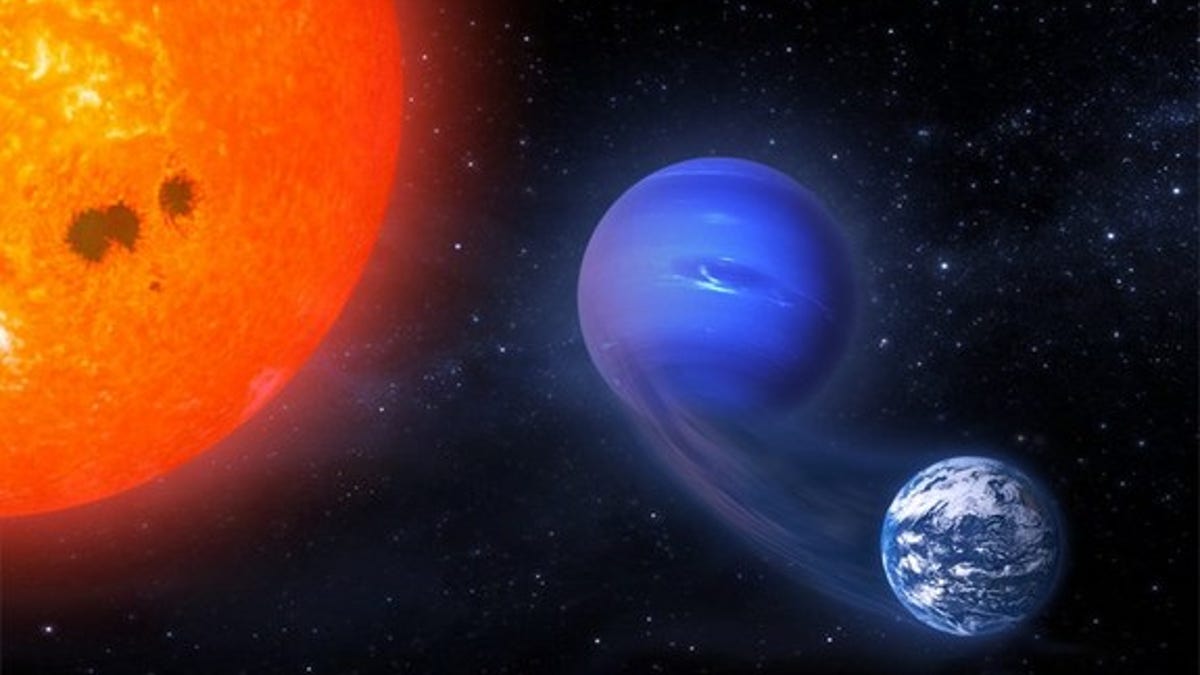
This artist's illustration depicts the transformation of a "mini-Neptune" exoplanet, orbiting a red dwarf star, into a potentially habitable rocky world. (Rodrigo Luger (adapted from NASA images))
Some Earthlike alien worlds may have looked a lot more like miniature versions of Neptune when they were born.
Frigid "mini-Neptune" exoplanets that take shape relatively far from red dwarfs — stars smaller and dimmer than the sun — could be dragged inward over time, eventually losing most of their thick gaseous atmospheres and ending up in spots warm enough for life as we know it to survive, a new study suggests.
Such stripped, rocky "habitable evaporative cores" (HECs) may be common around red dwarfs, which make up about 75 percent of all stars in the Milky Way galaxy, researchers said. [10 Exoplanets That Could Host Alien Life]
"Future research will have to address just how likely it is for HECs to actually be habitable," lead study author Rodrigo Luger, a Ph.D. student at the University of Washington in Seattle, wrote in a blog post. "Either way, these evaporated cores are probably lurking out there in the habitable zones of these stars, and many may be discovered in the coming years."
Red dwarfs are cooler than the sun, and they therefore burn through their fuel supply more slowly. In fact, scientists think these stars can keep on shining for trillions of years. (For comparison, the sun's lifespan is about 10 billion years.)
Red dwarfs, also known as M dwarfs, are very luminous and active in their youths, however. For hundreds of millions of years after they form, these stars blast out lots of high-energy X-rays and extreme ultraviolet (UV) radiation, which can erode or completely strip away the atmospheres of relatively nearby planets, Luger said.
Scientists have discovered a large number of mini-Neptunes — gaseous worlds more massive than Earth but smaller than "ice giants" such as Uranus or Neptune — orbiting distant stars. Mini-Neptunes consist of a rocky core surrounded by a thick hydrogen-helium atmosphere. Scientists think these planets form far from their host stars, where water and other volatile molecules exist as ice in the planet-forming disc.
So, mini-Neptunes around young red dwarfs would initially lie too far away to be reshaped by the stars' intense radiation. But computer modeling work performed by Luger and his team suggests that these planets could come closer to their stars over time.
This would happen because of tidal forces dragging the planets inward. These tidal effects arise from the fact that a star's gravitational pull is stronger on an orbiting planet's near (star-facing) side than the tug on the far side. Tidal forces can generate enormous amounts of internal energy, as the insides of a planet are stretched this way and that. And such forces can even cause planets to move, Luger said.
"The energy dissipated by the tides inside the planet has to come from somewhere. It turns out that it often comes from the orbit of the planet, which shrinks, bringing the planet closer to the star," Luger wrote in the blog post.
Some mini-Neptunes may thus migrate into the "habitable zone" (HZ) of their host stars — that just-right range of distances where liquid water could exist on a world's surface. There, the exoplanets would experience higher levels of X-ray and UV radiation, which could potentially strip away their thick atmospheres, leaving behind a rocky, Earthlike world.
"Such a planet is likely to have abundant surface water, since its core is rich in water-ice — once in the habitable zone, this ice can melt and form oceans," Luger wrote.
These HECs would be well-placed to possibly support life when the red dwarf calmed down after its initial high-activity phase.
"Many of the Earth-mass terrestrial planets detected in the HZs of M dwarfs in the coming years could be HECs," the authors write in the study, which was published this month in the journal Astrobiology. "These planets should have abundant surface water and are likely to be water worlds, whose potential for habitability should be investigated further."
